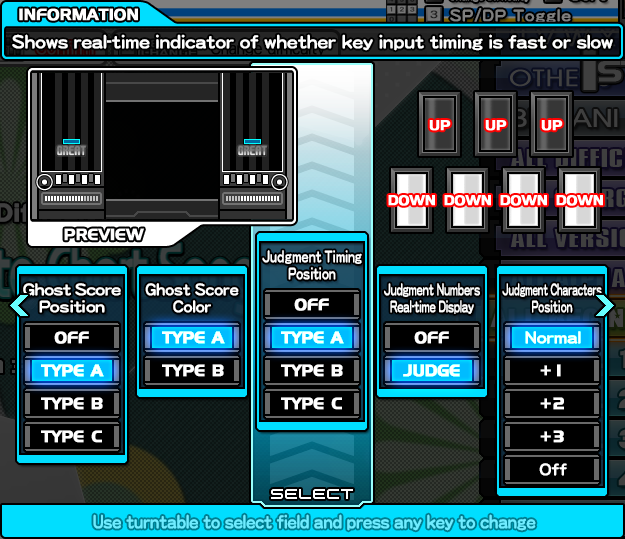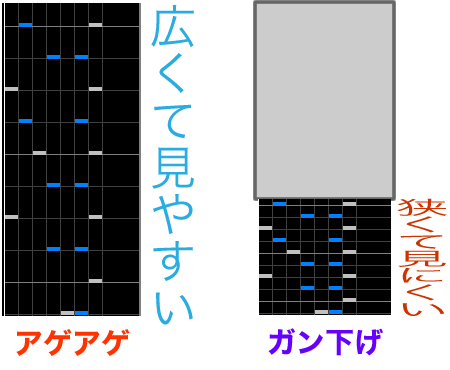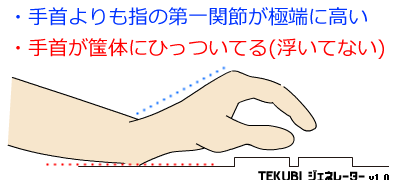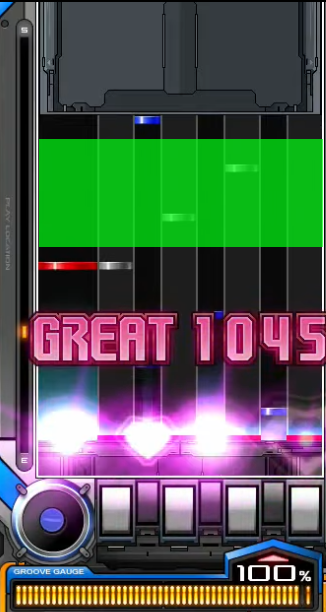Tips for Intermediate Level Players
Table of contents
Introduction
As stated in the section’s introduction, the audience for this article is for 8th dan to 10th dan players.
If you are already at 10th dan, Tips to reach SP Kaiden would also be good to read.
There will be a little bit of overlap between the two, if they are really that important.
Game options
Use Random
Use the random option for almost all songs when you are playing. Keep random on for playing easy charts, difficult charts, new charts, and especially your favorites that you play over and over.
The only real exception to turning off random would be when you are going for a clear on scratch-heavy songs, in which case non-ran or mirror is often used.
And yes, the random option, not r-random, and not s-random. See here for details.
Justification for always using random
The biggest upside of playing with random is that you get to experience a variety of patterns. Since IIDX charts are hand-crafted, there are many recurring patterns; for example, repeated bass notes on 1, stairs that go from 1-7 or 7-1, chords consisting of just the white notes or just the blue notes, 1/7 trills. If you play random, the game will challenge you with bass notes on 4, 1/2 or 6/7 trills, chords that are mixed up & difficult to read, and so on. These are just extreme examples to illustrate a point, of course.
It also prevents you from developing bad habits. For example, if you repeatedly play the same chart on non-ran, your brain may start to memorize the note pattern. This is not a good thing! Instead of developing the ability to read and process note patterns, you may be relying on your memory, recalling how to hit the notes without looking at each individual notes. The worst possible case is if you are doing this poorly – this may be due to incorrect memorization of notes, or from muscle memory preventing you from hitting the notes correctly. By playing random, you can prevent this memorization effect; if you always play with random, this wouldn’t happen in the first place.
Remember, this isn’t about using random to somehow make the chart easier or harder, or helping you get higher scores or lamps with a “good random”. It’s about improving your skills. Don’t fish for random, don’t immediately quit out if you get a difficult combination of notes; try to play every song to completion.
Turn on FAST / SLOW
If you haven’t already, go to the blue menu and turn on timing display. Put the display where you can see it – typically this is Type A.

On the result screen, check that your fast/slow ratio is roughly 1:1. If it isn’t, this page on timing is worth a read.
Keep your green number within reasonable range
At this level, a typical green number is between 270 to 320. If your green number deviates greatly from this, you might want to consider going back to more conventional setting and making small adjustments.
Avoid setting your green number extremely low, forcing yourself to play from pure reaction. This is a common pitfall for players at this level. While you may be able to keep up in the lower levels, your reaction time may not be sufficient once you start playing 11s and 12s. As the patterns get more complex, your brain will need more time to translate them into muscle movements.
Reduce your white number if it’s too high
If you use a high white number (if your lane cover or lift covers a lot of your screen), try to reduce it.

The idea is that – given the same green number – if the play field is too small, the spacing between notes are compressed vertically, making it harder to differentiate between them.
Typically, players cover about 5%-40% of the screen. If more than 50% of your screen is covered, strongly consider reducing it.
Source: https://the-safari.com/3103
Song Selection for Practice
Play more songs at your skill level
During your session, you should spend most of your time playing charts that are at your level.
Don’t bang your head against the wall trying to clear a song that is significantly above your skill level. Similarly, don’t waste your time trying to ex-hard or full combo clear a song way below your level.
You should be playing easier levels during your warm-up routine, of course.
Play a variety of songs
There are over a thousand songs in IIDX, and way more if you want to count each chart separately.
Back in the days, when there were very few songs, it was common for players to practice the same song over and over (e.g., playing Quasar or AA on random). This really hasn’t been necessarily in the last decade.
Therefore, try to play a variety of charts instead of focusing on a few. If you fail a song, maybe you can move onto other songs for now, and come back when you are ready again.
Use tier lists for Levels 11 and 12
Once you start playing 11s, you can use tier lists as a reference; this is especially useful when you are trying to play songs around your skill level.
When you are playing 12s, you should definitely check out the tier lists to start with the lower end. Songs in Level 12 folder span an extremely large range.
Use tier lists and lamp trackers as a motivator and to measure your progress. Remember that there are separate tables for normal and hard clears; you should use both.
Don’t worry too much about tier lists for level 10 and below, there are no good tables for these, and difficulty spread is much narrower in the lower levels.
See here for tier lists and progress trackers.
Physical Form
Reevaluate your playstyle
Here is a page on common playstyles.
The most common playstyle at this level is transitional 1048, so if you are still unsure, this is a safe choice.
If you are playing an uncommon playstyle, it’s time to reconsider and see if you can adopt to more common one. You may have developed an odd playstyle along the way while playing lower levels, which may quickly become less than ideal as you progress through the game. There are reasons why some styles are less popular.
Every playstyle is viable – there are plenty of players who can pass kaiden with one hand, even; but not every playstyle is the most efficient at making progress.
Watch your form
Don’t do this:

Lift up your wrist like this, but not too high:

and remember to hit the keys with the tip of your fingers.
Source: https://the-safari.com/3072
Keep your eyes focused
Try to keep your eyes focused on one spot. Where on the screen depends on each individual, but typically, players look at the area slightly above the judgement text.
If you are unsure what that means - try to look only within the green box. (Exceptions would of course be made for sof-lan songs when BPM significantly lowers.)

Try your best to avoid your line of sight from dropping lower over time. Make a conscious effort to “reset” your focus back to the green zone if your catch yourself doing this.
Avoid scanning the screen up and down - try not to have your eyes follow the notes as they scroll down, instead you should be focused on one spot of the screen and scanning the notes pass through the green zone.
